- The Bloomberg Terminal offers users real-time access to global news, financial data, and analytics tools.
- Historically, only for-profit financial organizations have used the Bloomberg Terminal, but the advocacy community could be leveraging its vast resources to enact change.
- Part 3 of a three-part series on using the Bloomberg Terminal in advocacy work explains some of the terminal’s advanced tools.
| Other stories in Mongabay’s series on using the Bloomberg Terminal in advocacy work: Part 1: How to use the Bloomberg Terminal for advocacy work: the basics Part 2: Tracking assets for environmental advocacy work with Bloomberg |
The previous two articles in this three-part series detailed some of the basic functions of the Bloomberg Terminal — Windows-based proprietary software that many financial organizations rely on for news, financial data, and analytics tools — and described how they might be of interest to the advocacy community.
This third and final article will introduce some of the Bloomberg Terminal’s more advanced offerings. These include data on global weather trends, country risk assessments, and Excel templates that can be used to analyze anything from a country’s so-called Environmental, Social, and Governance risk score to commodity pricing strategies.
Determining whether a particular asset — for instance, a commodity like palm oil — is correctly priced or over- or undervalued by the market can give a buyer or seller an advantage in negotiating to trade the asset. It can also give an advocate leverage to influence producers and traders. But determining the appropriate price of an asset can be difficult, since so many factors influence price, from weather to trade agreements between countries. The Bloomberg Terminal offers pertinent information and tools to assist in these assessments.
One of the terminal’s more useful tools is its weather-forecasting function. Global temperature and weather patterns strongly influence companies’ agricultural strategies and output. When it comes to palm oil, for example, the Bloomberg Terminal offers information on precipitation, soil moisture, and weather forecasts in Asia, where the plantations are concentrated.
This kind of information is useful for traders trying to determine how the future production of a commodity like palm oil will affect future demand. For instance, the potential for droughts or flooding will impact the supply of palm oil and therefore the price. Advocates might find this information useful in determining which commodities or companies are likely to be affected most by such price changes. A reduction in the price of a particular commodity could significantly impact the revenue of firms that trade the commodity, making them more susceptible to outside pressures like boycotts or petitions.
Users can find weather information by entering WEAT (short for “weather”) in the command line and pressing the GO button on the proprietary keyboard that comes with the Bloomberg Terminal software package. Users can easily switch regions and weather parameters. The screenshots below show the precipitation information available on the terminal for East Asia (unfortunately, split between two screens).
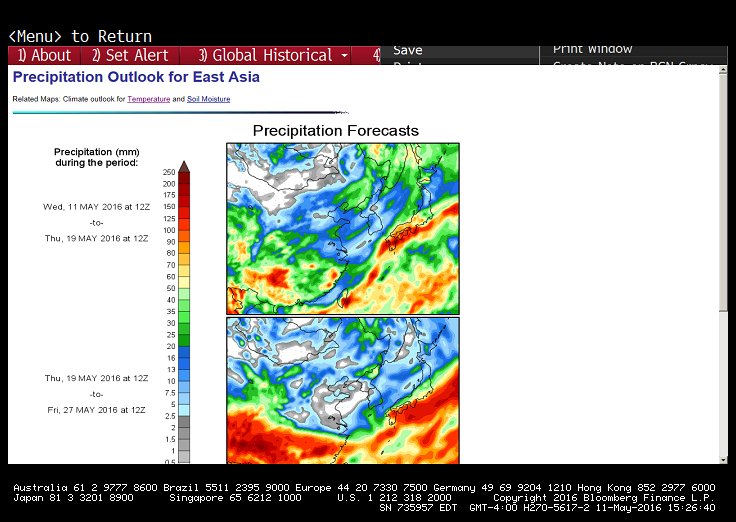
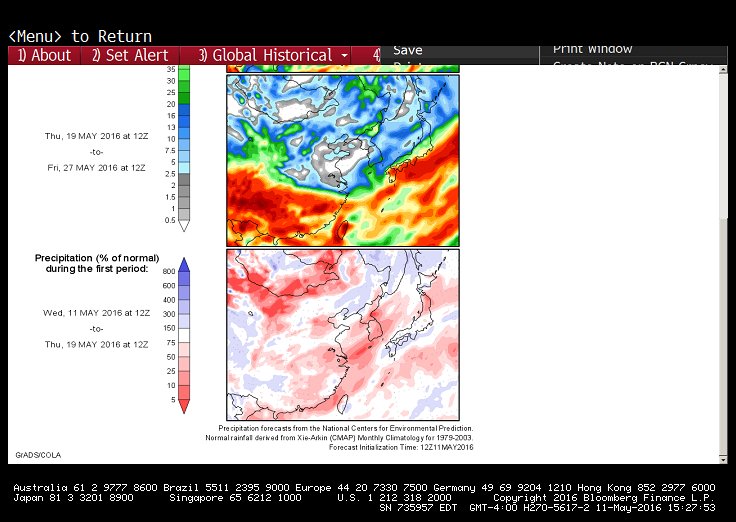
The Bloomberg Terminal also offers a powerful tool in the form of a comprehensive suite of Excel templates that users can download and manipulate to analyze the current price environment for any number of commodities. Each template has relevant formulas embedded in it, and a user can input relevant data and assumptions.
Users can find the list of available templates by entering XLTP (short for “Excel template”) in the command line and pressing the GO key. The screenshot below shows the main template screen, which displays some of the more popular templates along with brief descriptions of each one.
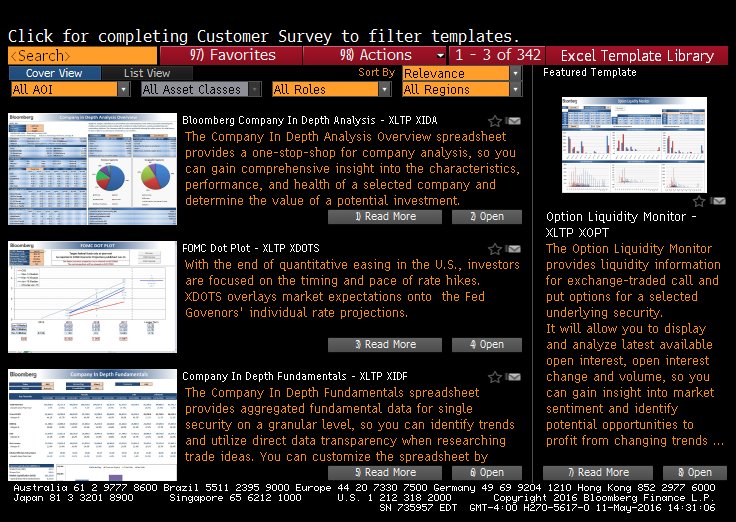
One of the terminal’s most useful templates is the Country Risk Assessment template. The template offers a “Country Risk score” for more than 80 countries, which Bloomberg describes as reflecting “the chance that most or all economic agents (including the government) in a particular country will, for some common reason, become unable or unwilling to fulfill international financial obligations.” It also provides the financial, economic, and political risk indicators that factor into the score. This template is helpful for traders or advocates analyzing how country or region-specific factors can affect the price of goods produced in certain countries, or the value of companies operating or headquartered there. The screenshot below shows the overview of the Country Risk Assessment template.
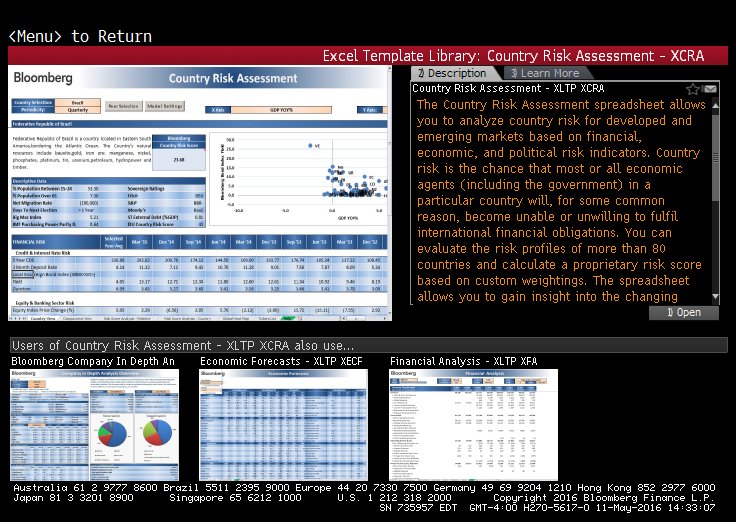
The templates are user friendly and intuitive. Users can downloaded them by clicking the “Open” button next to the description for each template. The screenshot below shows a portion of the Country Risk Assessment spreadsheet for Malaysia, including sovereign debt ratings from multiple ratings agencies as well as demographics information. Additional screens provide further financial information on the country in question.

Another template that may interest the advocacy community is the Environmental, Social, and Governance (ESG) Country Strategic Risk spreadsheet. It provides an overall ESG risk score for the selected country, and covers the key factors Bloomberg uses to calculate the score, such as energy use, greenhouse-gas emissions, employee safety and diversity, and corporate governance. The screenshot below shows the Bloomberg screen with an overview of the ESG Country Strategic Risk template.
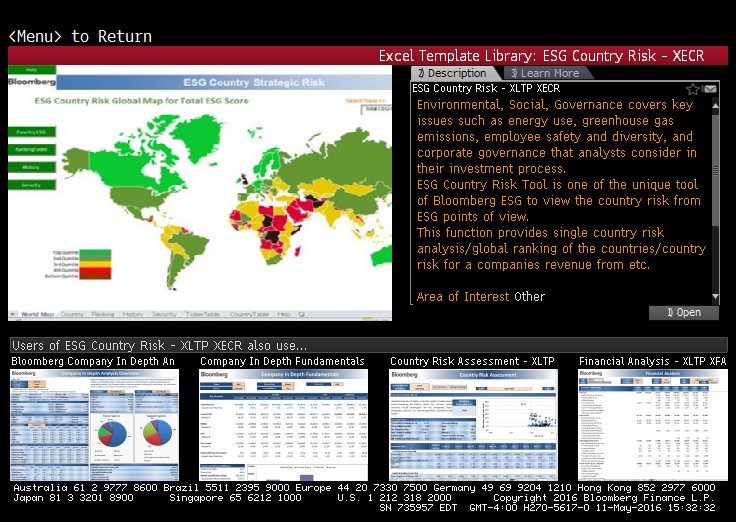
The screenshot below shows a portion of the ESG Country Strategic Risk spreadsheet for Malaysia. The three main ESG categories are broken down into specific variables like energy, human welfare, economic freedom, and corruption. These variables are all significant from both a financial and an advocacy perspective. The advocacy community could also submit data and research to Bloomberg to improve the quality and coverage of this type of information.
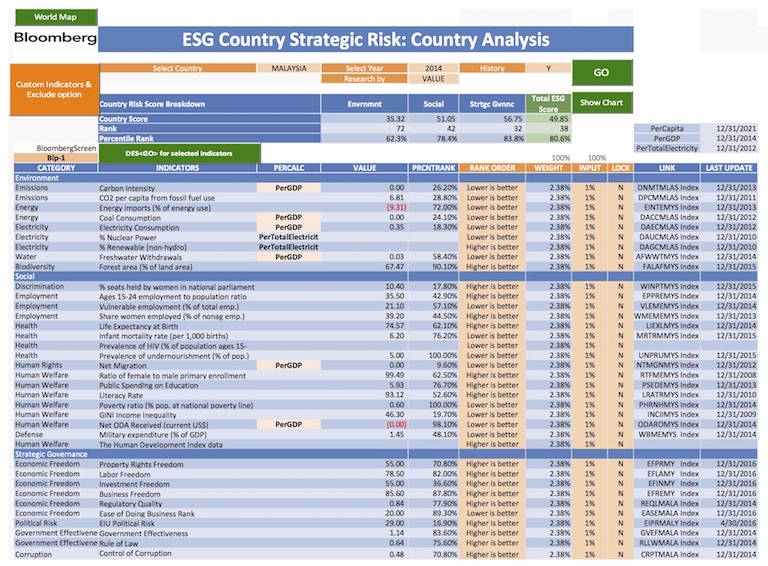
A country’s ESG risk can impact corporate activities within its borders. Countries with higher ESG scores are more likely to scrutinize corporate activities, which makes it harder for companies to get away with violating environmental, labor, or social welfare laws.
Commodity pricing is not a simple task and requires the consideration of multiple variables as well as complex calculations. The Bloomberg Terminal has Excel templates that allow users to price commodities contracts based on various inputs. The screenshot below shows the overview of the Commodity Price Forecast template, which includes individual analysts’ estimates, as well as statistical indicators such as mean and median prices. Users can customize their calculations based on these inputs and analysts’ recommendations.
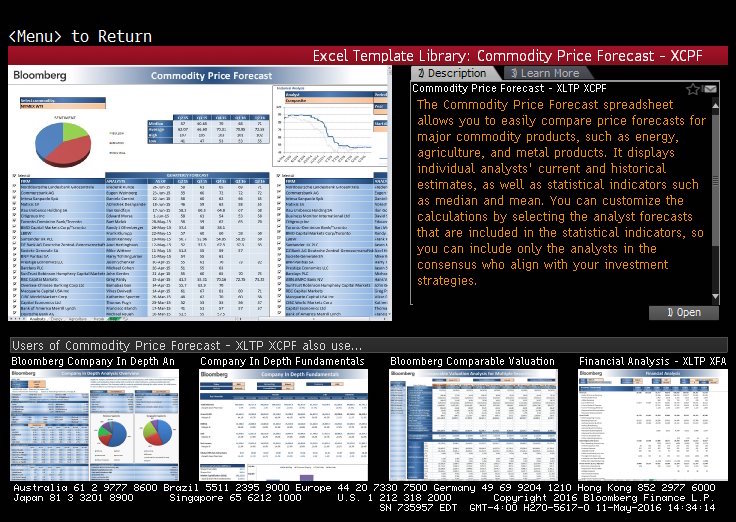
The screenshot below shows the first page of the Commodity Price Forecast template for a grade of crude oil (as in the fossil fuel) known as West Texas Intermediate, or WTI. The chart shows price forecasts in U.S. dollars per barrel from specific analysts for each quarter and indicates when the forecasts were made. The pie chart aggregates the sentiment of all analysts covering the commodity.
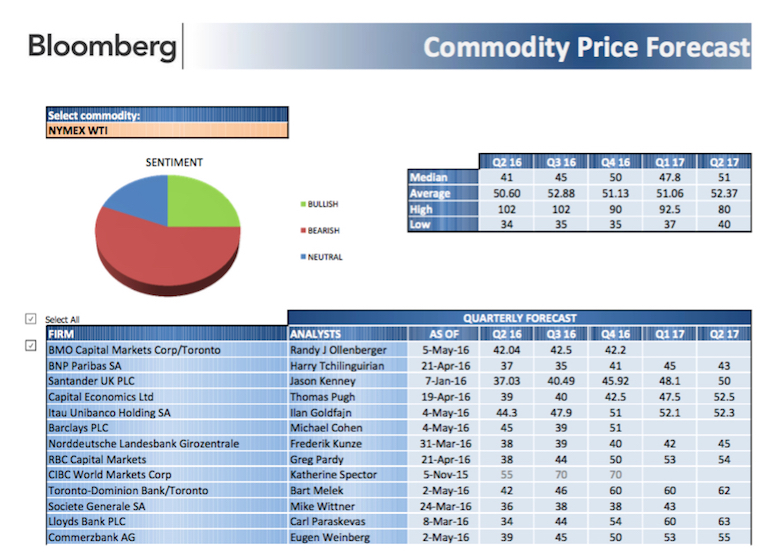
Trading or purchasing goods in foreign countries requires currency conversion and analysis of currency risk. The Bloomberg Terminal offers significant insight into the currency markets. This information can be found by pressing the yellow FX key along the top of the Bloomberg keyboard followed by the GO key. The screenshot below shows an overview of the currency market, including the current exchange rates for the most popular currencies as traded against the U.S. dollar. Users can select different base currencies to suit their needs.
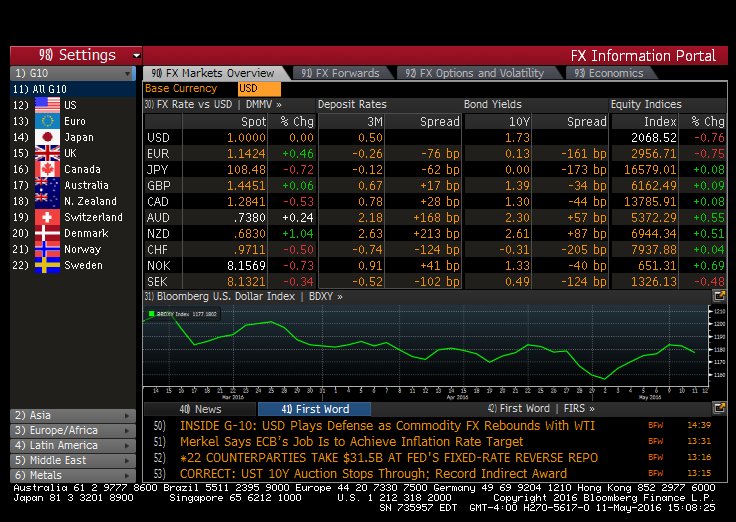
Users interested in the price of palm oil in Malaysia would want to know the U.S. dollar to Malaysian ringgit conversion rate. The screenshot below shows some of the price points various exchanges offer.
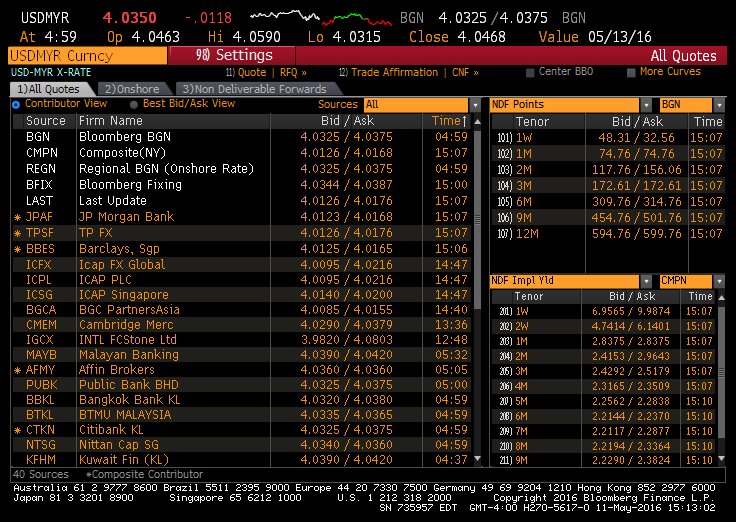
As an example of how the kind of data available on the Bloomberg Terminal can help make sense of real-world events, consider the case of one of the larger palm oil producers, the Malaysian company Felda Global Ventures (FGV). In March 2016, FGV representatives reportedly acknowledged clearing 880 hectares of Malaysian peatlands designated as “High Conservation Value.” The clearing violated criteria of the Roundtable on Sustainable Palm Oil (RSPO) for certifying a company’s palm oil as sustainable. The violation, coupled with other infractions, appears to have helped force FGV to voluntarily request the withdrawal of the RSPO certifications for 58 of its mills in May.
A month earlier, a report from the Washington, D.C.-based sustainability risk analyst Chain Reaction Research used data and tools from Bloomberg to analyze the potential financial impact on the company of the loss of its certifications. The report estimated that the company risked losing between $6 million and $12 million if it could no longer sell its palm oil as certified-sustainable, which would prevent it from selling to large companies with zero deforestation policies. Certified sustainable palm oil also often sells at a higher price than its uncertified counterpart.
FGV says it is currently revising its policies and procedures to prevent future infractions and pursue recertification. Presumably, FGV’s leadership understood the potential loss in revenue associated with losing RSPO certification, so they took action to self regulate.
This example highlights how accurately pricing assets—in this case certified versus uncertified palm oil—as well as the ability to track assets to market (as discussed in my previous article) can help encourage corporate compliance with market-based environmental standards. Leveraging the Bloomberg Terminal to analyze and track palm oil or other commodities with heavy environmental footprints across all firms could help sway entire industries.
In short, the terminal could help the advocacy community understand and reveal how risks associated with environmental and social factors impact companies’ bottom lines. This, in turn, could help advocates exert financial influence to force corporations to alter their actions — one of the most effective tools in their playbook.
Citations
- Chain Reaction Research (2016). Felda Global Ventures (FGV:MK). Washington, D.C.:Chain Reaction Research.

